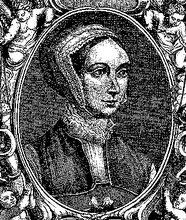Within the frame of the Stonyhurst picture of Blessed Thomas Tunstall is a sliding panel on which is written a short piece about the martyr. Sadly, this writing is not dated yet it must have been written after 1706 (a date mentioned in the text), and before 1828 (the year in which the painting came to Stonyhurst).
The text tells how Fr Tunstall was held for four of five years in Wisbech Castle, and after his condemnation was held in Norwich Castle (not the old city Gaol, which I had previously indicated). And that at his execution he showed more than natural courage, and prayed for his accusor and thanked him for being instrumental in his death.
After his execution his quarters were displayed at various parts of the city. These were later taken down by Catholics in the city and kept there until 1706, when they were given to a Benedictine who placed them in an altar at Bath.
These few details about a young priest, originally from Whinfell, just north of Kendal in Westmorland, who gave his life freely for Christ just outside the Magdalene Gate of the city of Norwich, where Magpie Road meets Bull Close Road, reveal an extraordinary character and a saint, who has marked this country and the city of Norwich by his commitment to the Mystery of Christ. This is a glorious story, and the more we uncover about the lives of these Blesseds, the more we too can honour Christ and by changed by His presence.
There really should be a memorial to Fr Thomas Tunstall at the Maudlin Gate. This isn't a story to be kept in the dark or in secret. It is full of virtue and of light.
Grateful thanks to Stonyhurst College for the image and permission to reproduce it here.
















